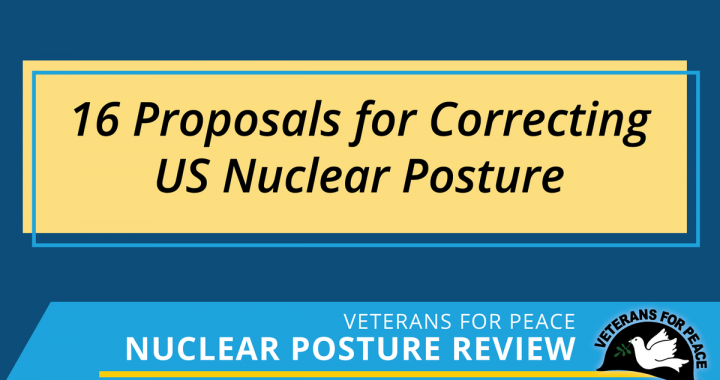By Leonard Eiger
February 8, 2022
A new Nuclear Posture Review (NPR) is issued every four years and, although officially a “legislatively-mandated review that establishes U.S. nuclear policy, strategy, capabilities and force posture,” it essentially paves the way for our nation’s continuing reliance on nuclear weapons. Presidents have used the NPR to implement their individual nuclear weapons agendas, and in the previous administration, it went a bit off the rails, and much attention was paid to the Trident nuclear weapons system.
MINI-NUKES ON TRIDENT?
The 2018 NPR dropped quite the bombshell when it called for essentially changing up the mission of the nation’s ballistic missile submarines (in a dangerous way). “…in the near-term, the United States will modify a small number of existing SLBM [Trident] warheads to provide a low-yield option…”
One argument for this approach was that the U.S. “will not require or rely on host nation support to provide deterrent effect.” This would appear to be a way to hedge our bets against other nations [in Europe] currently hosting our tactical nuclear weapons, in case they change their minds and tell us to remove them (which they should!).
Arming a “strategic” weapon like the Trident II D5 submarine-launched ballistic missile with a “tactical” warhead was an extremely dangerous recommendation. Currently, the D5 missile carries either (or both) the W76 (100 kiloton yield) or W88 (475 kiloton yield) thermonuclear-armed warhead. Either one is a dramatic contrast to a low-yield (likely no more than 10 kiloton) “tactical” warhead.
In a time of crisis, an adversary would not be able to distinguish the different incoming warheads, although they could detect a launch and know it was launched from a submarine. A nation under attack by warheads from any D5 missile, would have to assume the worst case scenario – a full-scale attack – and that would likely trigger full-scale (nuclear) retaliation.
HOW MANY TRIDENTS?
The 2018 NPR said that, “The COLUMBIA program will deliver a minimum of 12 SSBNs to replace the current OHIO fleet and is designed to provide required deterrence capabilities for decades.
This is clearly paving the way to build more than the 12 submarines called for in the current plan, and that would be nothing less than a make-work program for the weapons makers. Some experts, such as Plowshares Fund’s Joe Cirincione, have called for fewer than 12 New Tridents.
As Cirincione said, “If you just need this to be a deterrent force, to respond in case someone is crazy enough to actually attack the United States and thereby deter them from ever doing that, well, you really could be talking about four, five, six nuclear submarines, each of which would have 16 missile tubes, each of which would carry five or six warheads. That’s a lot of nuclear weapons.”
Of course, if even one of those Trident submarines launched all of its nuclear-armed missiles, that would be way more than enough nuclear firepower – in addition to the immediate and near-term deaths – to cause billions of deaths due to famine caused by the effects on agriculture and food supplies.
TRIDENT: THE CROWN JEWEL
The 2018 NPR continued to tout Trident as “the most survivable leg of the Triad” – the Triad being ballistic missile submarines, land-based missiles, and bombers. Under the U.S.-Russia New START treaty signed in 2010, roughly 70-percent of U.S. nuclear warheads either are or will be deployed on Trident.
It also stated that Trident is “at present, virtually undetectable, and there are no known, near-term credible threats to the survivability of the SSBN force.” And while saying that the U.S. will “hedge against the possibility” of advances in anti-submarine warfare that could threaten Trident in the future,” the 2018 NPR demonstrated some concern about how this could affect the “survivability” of Trident in the future.
“In coming decades, advances in adversary anti-submarine warfare and missile defense capabilities could challenge the effectiveness of current SSBN and SLBM systems.” The British American Security Information Council has researched and written extensively on the risks posed to Trident by rapidly emerging technologies, including unmanned underwater vehicles (UUVs) and hacking. Trident is, by no means, invulnerable to future threats.
Essentially, the 2018 NPR was saying that the Navy was preparing to build a new generation of ballistic missile submarines based on today’s threats. With today’s rapid advances in technology, it is highly likely that New Trident will face vulnerabilities right out of the starting gate, and that those threats will continually evolve.
A NEW MISSILE? OF COURSE!
The 2018 NPR confirmed what many already knew – the Navy, in addition to building a new submarine, is also “emphasizing the timely replacement for the D5 SLBM.” The current D5 missile is undergoing a second life extension program that will extend its reliability through the year 2080. Ironically, the Columbia Class will “be operational for the next 60 years.” Somehow, the Navy’s math skills are a bit fuzzy. The Navy planned to begin studies in 2020 on a replacement that will be viable for the life of New Trident, and one can imagine that Lockheed-Martin would be the likely winner of such a massive contract.
THE UPSHOT
Aside from the impacts on Trident, the 2018 NPR clearly demonstrated that the U.S. government is dead set on perpetuating The Doomsday Machine (the title of Daniel Ellsberg’s 2017 book). And, if President Biden’s apparent initial embrace of nuclear weapons is an indicator, the 2022 NPR may very well set the stage to pour billions of taxpayer dollars into additional devices of our nuclear extinction., continuing over seven decades of such preparation.
NPRs offer no meaningful focus on the use of diplomacy and conflict resolution, nor is there any mention of our obligations toward disarmament stemming from our participation in the Non-Proliferation Treaty. But we shouldn’t expect any of that in a document that is only intended to promote our nation’s continued reliance on nuclear weapons as the ultimate tools of foreign policy.
At a time of great geopolitical instability, we cannot be creating new controversy and building tensions. The next NPR could further destabilize already delicate and deteriorating relations with Russia, as well as other nuclear-armed nations, or it could provide assurances to Russia that the US wishes to reduce reliance on nuclear weapons.
We should use the Biden administration’s NPR to generate a public dialogue on just why we need (or need not) to continue on the same course as the ill-fated Titanic. The 2022 NPR will likely use fear as its driving force, citing the dangers posed by Russia (and China, among others), and yet it is the U.S. and Russia that must lead the world away from the false security of nuclear weapons. We keep driving each other deeper into the nuclear abyss, and at some point one or the other has to reach out a hand and say “ENOUGH!” There is no security in nuclear weapons, and they should, therefore, have no place in U.S. national security strategy.
AN (ALTERNATIVE) NUCLEAR POSTURE WE CAN ALL LIVE WITH!
Veterans for Peace (VFP) produced its own 2022 Nuclear Posture Review (VFP-NPR), and it provides us with a roadmap to eradicating the horrible nuclear Sword of Damocles hanging over humanity. It is an NPR that focuses on the pertinent issues and provides sound recommendations to reduce and/or eliminate the nuclear risks each poses – from Russia (and the other nuclear-armed nations), to the “nuclear umbrella,” to weaponizing space.
The VFP-NPR concludes by saying that, “ Our VFP Nuclear Posture Review provides a stark contrast to the Nuclear Posture Review being prepared for President Biden by the Pentagon, which will continue to justify the discredited idea of nuclear deterrence, while feeding billions more dollars to nuclear weapons manufacturers. We are providing a well-researched and credible alternative that reflects the global desire for nuclear disarmament and peace. We hope that the VFP Nuclear Posture Review will be a guide, a useful tool and an inspiration for all who wish a peaceful future for our children, our grandchildren and generations to come. “
Veterans For Peace is sending its alternative NPR to President Biden, to Vice President Kamala Harris, and to every Member of Congress. I urge you all as citizens to magnify this critical message – download the VFP-NPR and send it to the folks in D.C., urging them to read it and implement all sixteen of its recommendations, while working to uphold our nation’s obligations under international law. It is time to bring the greatest possible pressure on our government to comply with its legal and moral obligations to end the threat of global nuclear annihilation that will continue to exist so long as the nuclear-armed nations rely on nuclear weapons as tools of foreign policy.
Click here to find contact information for our elected officials in Washington, D.C.
Click here to read the VFP press release on its Nuclear Posture Review.
NOTE: A webinar on the VFP (alternative) Nuclear Posture Review is set for this Saturday, February 12th at 2:00PM EST. It features an all-star lineup and is sure to be informative. Click here for more information!
###




